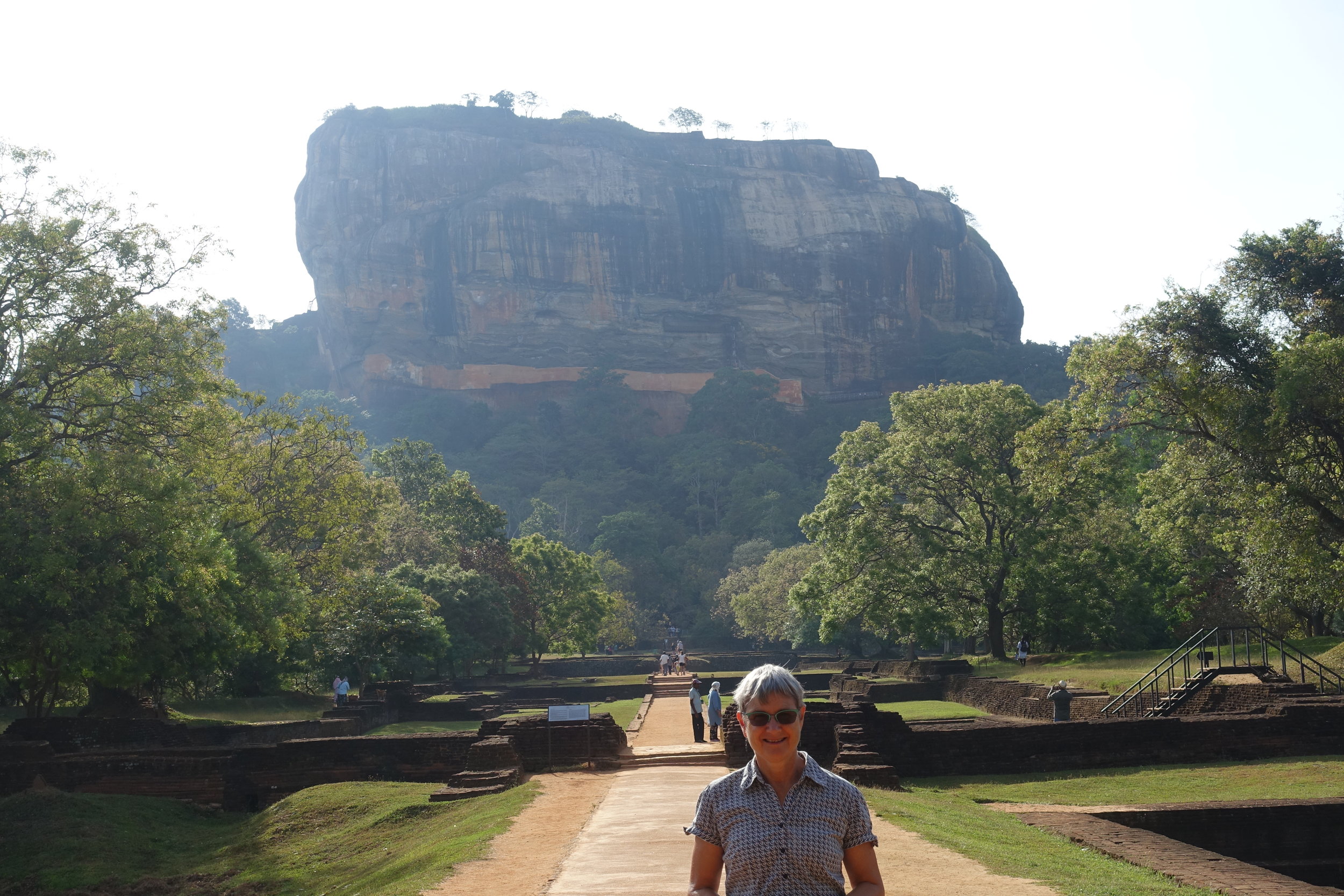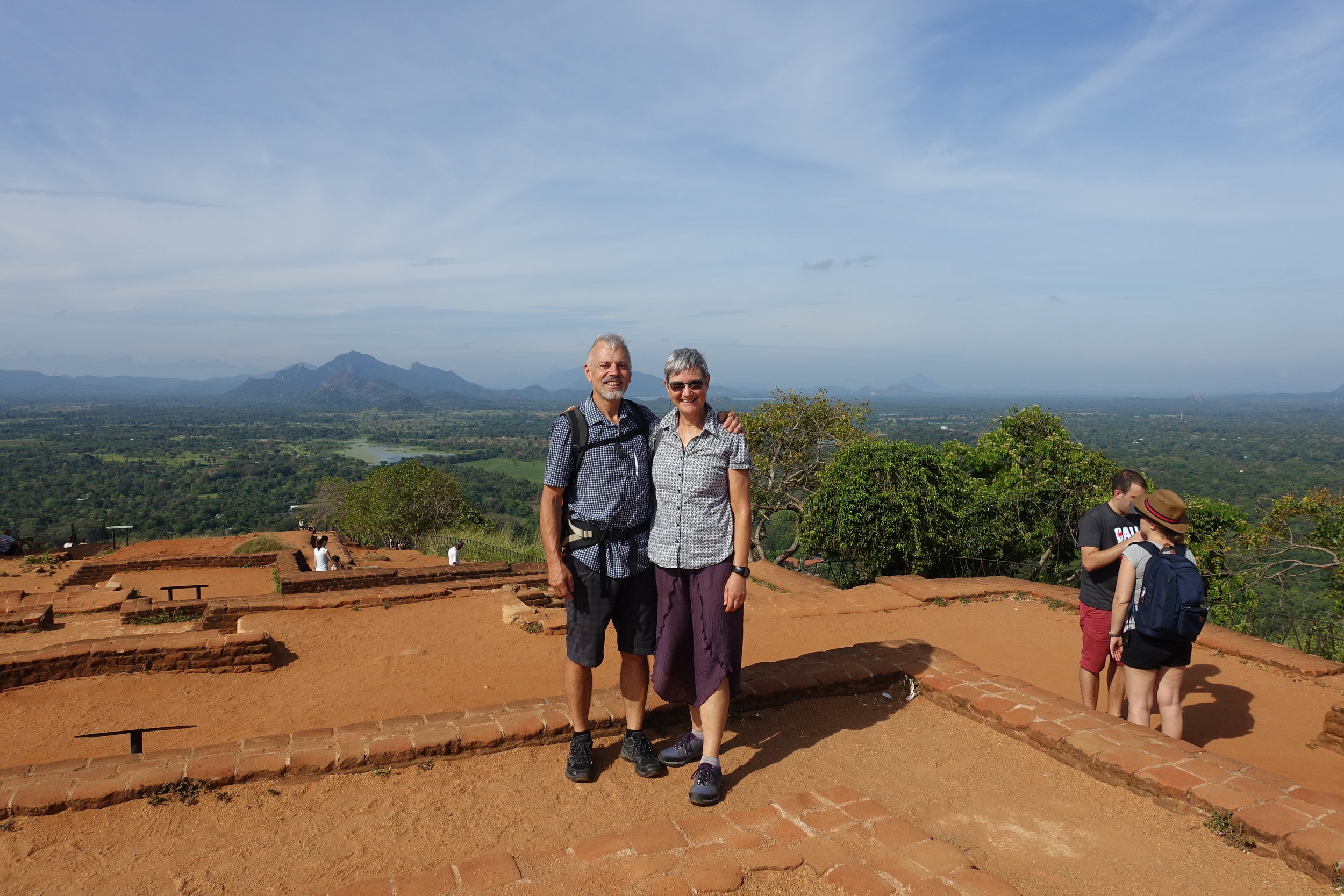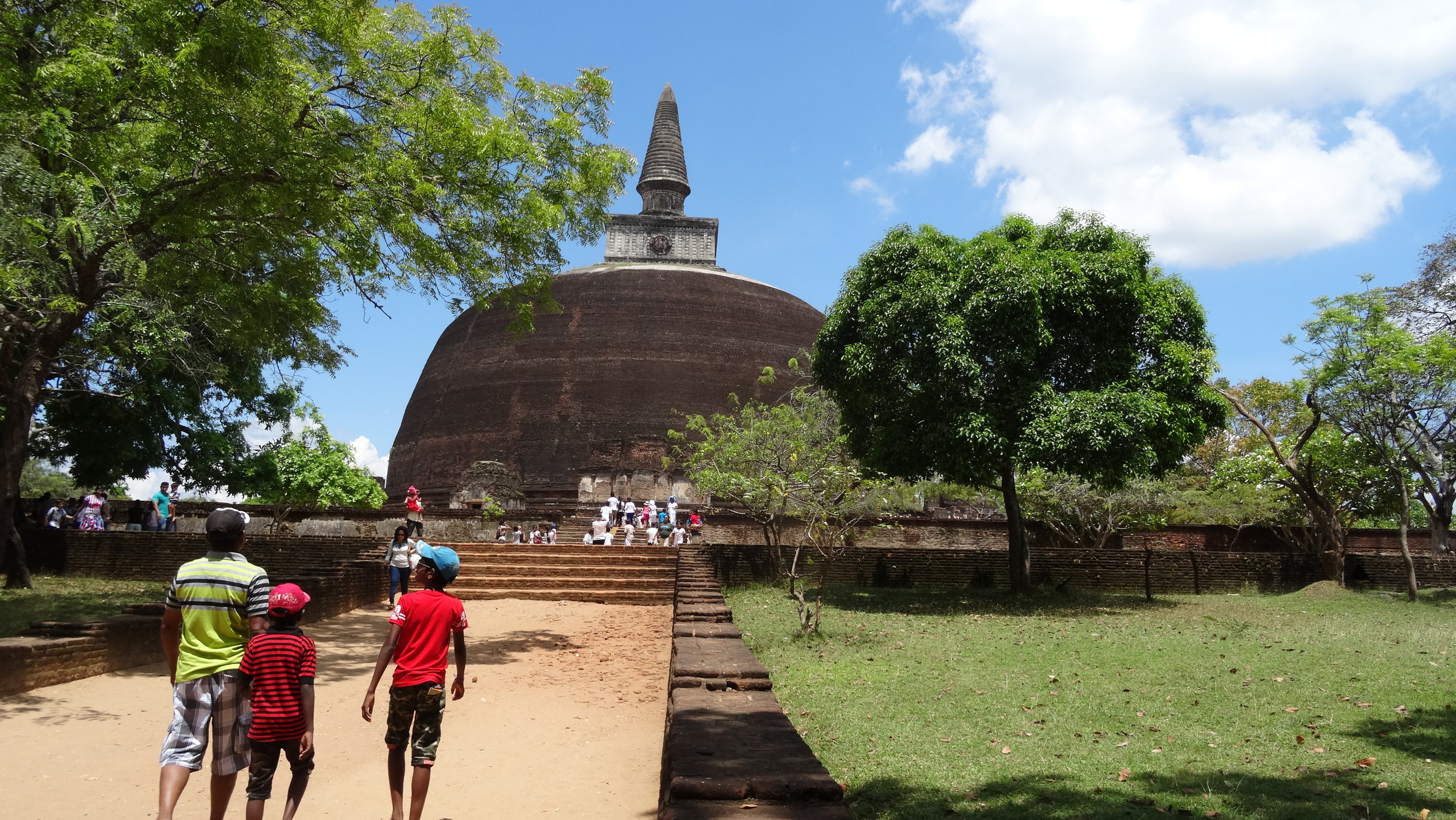Sri Lanka: Colombo to Kandy - including the heritage sites of Sigiriya and Polonnawarua
Louise George
Sigiriya from Pidurangula
When we went to the station to purchase tickets the day before yesterday, we had been told at the Tourist counter we couldn’t prebook and that there would only be 3rd class carriages available. “For the 6:05 departure, get to the station at least by 5:45, go to Counter 3, and expect to have to do some shoving!”
Having left the huge amount of gear, (enormous suitcase and chockka full overnight bag) needed for Europe, (how we are going to carry it all on two bikes, is yet to be realised); we are down to travelling with a day-backpack each. The Grand Oriental Hotel is in a quiet area and at 5:15 a.m. there are not the many sleeping Tuk Tuk drivers we were expecting to see; in fact there are none. None show before we reach the street corner, so we decide to return to the hotel reception to see if they will call one. The receptionist comes outside, looks into the Tuk Tuk parked outside and shrugs his shoulders. His small attempt to help, produces the same result as we got. Nothing! By the time we walk, at just under jogging pace to the station, we are hot and sweating. There is no long queue and we are pointed to Counter 2 for tickets on a 2nd class carriage. Nice surprise! We are observed looking for Platform 4, by an astute man who appears to be deaf mute, he guides us onto a dark carriage, then produces a card that indicates he’s a ‘station scout’ and then displays a page of information about a Deaf school, and note book of people’s names, country and donations they have made; some rather large. We duly follow with a small contribution; that in his opinion doesn’t warrant an entry in the notebook, as it is quickly removed before we can write in it. The assistance was helpful, but I’m skeptical that this is a tourist scam. There are 7 people on the carriage, not the hoards with standing room only, as we expected!
Whirling ceiling fans and air from the open windows did nothing to cool the carriage. The only way to escape the cloying heat was to doze intermittently. The journey of just over 5 hours was an interesting view of paddy fields at various stages of cultivation, and fruit trees, giving the impression of subsistence farming. We had snacks for the train; peanuts, mandarin and Easter Egg. Nev went on to the platform at one of the long stops, and returned with two delicious curried egg samosas.
We settled in to Le Grand Meaulines, and then walked the 1&1/2 km into Habarana to find lunch food. An afternoon nap snuck up on both of us, and we realised now that home (Adelaide) was six and a half hours ahead, we were probably jet lagged. We ate dinner of a ‘set course’, many curry dishes and rice, followed by fresh fruit, then went to bed early and slept ‘like logs’, in spite of our earlier napping.
We chose to eat breakfast at 6:30, as we want to beat the heat and crowds at Sigiriya. A Tuk tuk driver, already with a passenger, offered us a free ride just 200 metres to Habarana Junction; that seemed a little odd, and only a little generous, but we climbed in. At the Junction he dropped his passenger and then offered us a paid ride to Sigiriya 17 km away. The speed limit for a Tuk Tuk is 40 kph. The driver wound that little machine up to 60 km per hour as we hurtled along a quiet road, bordered by jungle.
As soon as we’d purchased the entrance tickets we headed to the top. The sun was already out in full force. The stair climb was harrowing. Concrete was soon replaced by a steel platform, supported by steel braces that were embedded in the rock. The final section was climbing almost upright, steel steps. What an amazing view of 360 degrees was visible from atop this enormous flat rock.
Sigiriya had been a city created in 5th century AD by King Kashyapa and was composed of buildings, pathways, ponds and terraces. We wandered amongst the ruins, seeking shade wherever possible. It was fascinating trying to imagine royalty living at this height, particularly trying to visualise how difficult it must have been to get people and goods to the top of the rock. King Kashyapa had plotted the assassination of his father and overthrew his brother, so probably protection was his prime motivation to rule from such a height. Back at the base the museum gave an interesting overview of the history of the region.
Another Tuk Tuk ride took us to Dambulla, and we started the afternoon with a ‘set lunch’. So much food! We found these rice and curry meals the norm for a meal in Sri Lanka; similar to last night’s dinner; an enormous amount of rice (too much usually) and at least five curries. Another Tuk Tuk dropped us at Dambulla Caves. We didn’t expect to climb many steps but were quite wrong, as there was at least a twenty minute climb up to the Caves. So many steps for already weary legs! Dambulla Caves is an area of five rock cave temples. We have to remove our shoes and hats: the flag-stone is hot underfoot! At least in the temples it is cool. The Caves contain about 150 Buddha statues. Some Buddha images were created here 2000 years ago.
We ambled our way the 2km back to Dambulla, past one of Sri Lanka’s biggest wholesale markets that looked like a constant stream of trucks and Tuk Tuks arriving with bananas and pumpkins etc. We needed to sit, and cool down, as we find the heat and humidity drains our energy, so continued to walk back to Mango Mango cafe, where we had eaten lunch, for some cool aircon and a Coke.
Almost the final excursion on this epic day, was a Tuk Tuk to Pidurangula for another climb. The driver made it quite clear we should come down at 6:30 following sunset. He would pick us up at 7, by this stone step, and the fee would be R1300. He repeated this a few times to make sure we got it! The climb was up irregular stone steps, through the treed slope of the hill, past the ruins of cave dwellings where Buddhist monks once lived, and just beyond a reclining Buddha the steps finished and the route became a rock scramble. I found it pretty scary but forced myself to push on, facing my fear to squeeze under a large flat rock slab and finally breathe in relief as we were now out to a large reasonably flat, open stone hilltop. We enjoyed the amazing views back to Sigiriya. We could see people (tiny as ants) climbing, as we had done this morning. I made my way down just after 5. I had no intention of negotiating the climb in the dark. It was almost dark when I got near the bottom and at this point a couple of naked bulbs lit the path. I realised I had the headlamp that Nev would need, and it would be completely dark when he descended. Oh dear!
A man came up to me and said the ticket office had rung him because our Tuk Tuk driver wasn’t coming now. He asked if I had come from Dambulla and I said no, because I thought ‘if he is lying to me, then I’ll lie to him’. I told him I was waiting for Nev and my driver.
Nev came down early because with the blanket of cloud it was obvious there was not going to be a brilliant sunset. In spite of the new Tuk Tuk driver pressurising us the leave with him, I insisted we wait until 7. Guess what? Our driver didn’t turn up! By now it was dark and not many people left. The new driver wanted more rupees, he pretty much had us to ransom. I refused to go with him and arranged with the van driver of the only vehicle still in the area, to drop us at the main road and we’d catch another Tuk Tuk. I’m sitting in the van waiting for Nev to get in, when he says the Tuk Tuk driver has agreed to our original price and we’ll go with him. I was not happy and the driver was pissed off, espousing that he couldn’t drive in the Sigiriya park in the dark and he’d have to take the back roads, so he took off on an unsealed road at a great rate, dodging pot holes. We got to tarmac and he said he wanted to get his friend, in case something happened, and we turned onto another dirt road and we were left in the dark while he went to get his mate. I was freaking out. Dumb tourists in the dark, in the jungle in Sri Lanka, with a driver that they’ve pissed off, now getting reinforcements to steal our money and dispose of our bodies. Yes I was that dramatic! Nev stuffed the few items we carried, into one bag and tucked it on the floor behind his legs. The driver came back with another man, who sat beside me, and we headed to Habarana. Nev made small talk and it seems there was genuine concern of the driver that he could come to a mishap on the road, vehicle breakdown, or elephant attack, and may need support; (clearly my reaction had been irrational), and then the heavens opened. The rain was torrential and visibility almost nil! We blindly continued at a slower speed and then after about five minutes, thankfully the rain stopped. I’ve never been so pleased to arrive at a destination and headed straight indoors, leaving Nev to try and convince the driver that we did not want his services tomorrow.
We walked in to Habarana Junction, and caught the bus to Polonnawarua. Rather than watching the scenery, we were drawn to the screen at the front of the bus aisle, that showed video clips of elephant attacks on occupied vehicles, such as an elephant’s leg weight smashing through a windscreen; motorcycle riders dropping their machines and running for their lives. Fortunately our journey was without mishap. Bikes were offered the moment we got off the bus, and before we knew it we were cycling beside the pretty lake to the first historic sites of interest, and then back to the main archeological site entrance.
Today is Vesak Day; a public holiday held at the time of the first full moon in May; to celebrate the birth, enlightenment and death of Buddha. Their are many families visiting the site, paying homage to Buddha. Many wear white as a sign of respect.
It’s extremely hot and a condition of entry to many of the ancient religious areas is to remove hats and footwear. Delicate feet that have rarely been barefoot these past years are now tentatively trending the rough flagstones and desperately seeking any shade offered. Sandals, not turned upside down, become heat absorbers, and inserting the feet seems to me as painful as walking on hot coals.
Kings ruled from here 800 years ago and it was an important commercial and religious center. The Polonnawarua site is spread over many square kilometres and the bikes are a great way of getting around.
The return bus to Habarana is full, apart from the two seats directly behind the driver. A man already occupies the third space on the bench, the seat closest to the window. Almost immediately I nod into a ‘heat exhaustion’ coma. When I finally rouse myself enough to focus, I can’t believe that we are in the hands of a maniacal driver. This guy only has one speed, and that is as fast as possible. He almost runs into the rear of vehicles in front (some are small pick-up trucks, with passengers in the back) to exert his bus-size dominance. He seems to only overtake on blind corners, scattering the small vehicles he is overtaking and forcing oncoming vehicles off the road! In one overtaking manoeuvre, we narrowly miss side-swiping a concrete bridge railing, on the opposite side of the road! We’re on a bus; not a little racing car! The bus stops at the small village just a couple of kilometres from Habarana. The driver gets off for a break, as do some of the passengers. We then proceed to Habarana in a civilised manner. We conclude that the maniacal driving was to make up time for a break, or he was desperate to go to the toilet.
We’ve finally got it! A Red bus is a government bus, blue buses are private; only take a red bus. At least we have a seat mid-way down the red bus. We think it’s good that we can’t see the road ahead (we won’t be able to see any havoc the driver creates) but it’s still three hours of heat, sitting squeezed into a cramped space. It’s Day 2 of Vesak, and many people are on the road. The bus is soon standing room only. I’m not sure when the driver started his section, but it’s been 3 hours with no breaks, and I hope he still has the concentration it takes to drive on two lanes that expand to four, or however many are needed to keep the layers of traffic moving.
























